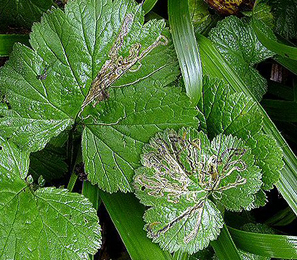|
||||||
|
Stigmella
pretiosa (Heinemann, 1862) Water-avens Pigmy Nepticula
pretiosa
Heinemann, 1862. Wien. ent. Monats.
6: 261. |
||||||||||||||||||||||||||||||||||||||||||||||||||||||||||||||||||||||||||||||||||||||||||||||||||
Leaf-miner: The initial gallery has frass in an interupted black line (British leafminers). Egg usually at the upperside of the leaf. The mine is a long, strongly vein-determined corridor. In the first part the frass lies in a rather narrow, often interrupted central line; further on the frass line is broader and more diffuse. Frequently more than one mine in a leaf (Bladmineerders van Europa).
Larva: The larvae of moths have a head capsule and chewing mouthparts with opposable mandibles (see video of a gracillarid larva feeding), six thoracic legs and abdominal legs (see examples). Yellow; described by Gustafsson and van Nieukerken (1990a) (Bladmineerders van Europa). Pupa: The pupae of moths have visible head appendages, wings and legs which lie in sheaths (see examples). Adult: The adult is illustrated in UKMoths. The species is included in mothdissection.co.uk. Hosts in Great Britain and Ireland:
Hosts elsewhere:
Time of year - larvae: September-November (British leafminers). Time of year - adults: Currently unknown. Distribution in Great Britain and Ireland: Discovered in Scotland in 1990. It occurs at least as low as 50m in damp, shady riparian Birch and Alder woodland in Sutherland (British leafminers). Dumfrieshire (NBN Atlas). See also British leafminers distribution map. Distribution elsewhere: Widespread in continental Europe including Austria, Czech Republic, Danish mainland, Estonia, Finland, Germany, Latvia, Lithuania, Norwegian mainland, Poland, Slovakia, Sweden and Switzerland (Fauna Europaea). NBN Atlas links to known host species:
British and Irish Parasitoids in Britain and elsewhere:
|
||||||||||||||||||||||||||||||||||||||||||||||||||||||||||||||||||||||||||||||||||||||||||||||||||
|
|
|
| External links: | Search the internet: |
|
Belgian Lepidoptera Biodiversity Heritage Library Bladmineerders van Europa British leafminers Encyclopedia of Life Fauna Europaea NBN Atlas NHM UK Checklist UKMoths |
Find
using Google Find using Google Scholar Find images using Google |
| Last updated 12-Jul-2019 Brian Pitkin | ||

